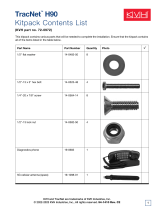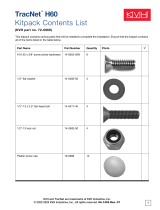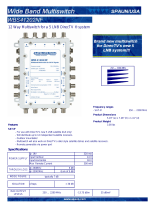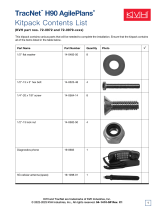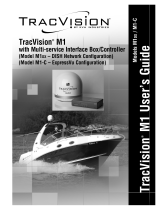Page is loading ...

Satellite Television
KVHTracVision
®
4
technical
manual
•
Installation
•
Configuration
•
Maintenance
A Guide to TracVision 4

TracVision 4-HP
Technical Manual Addendum
(ECO #7622)
The following changes apply to Revision G of the
TracVision 4-HP Technical Manual (KVH Part Number 54-0150).
4.3 TracVision 4 Field
Replaceable Units
Table 4-1 has been updated to show the new part number for the RF PCB.
FRU Part Number
Radome 02-0925-04
Main PCB 02-0992
RF PCB 02-1524
Antenna Gyro Sensor 02-1090
Antenna Gyro Gasket 24-0139
Elevation Drive Belt 24-0105-104
Elevation Motor 02-1356
LNB (North American System) 02-0870
LNB (European System) 02-1278
Data Cable 32-0619-50
†
32-0619-100
††
RF Cable 32-0417-50
†
PC Cable 32-0628-06
Power Cable 32-0510-50
Ground Cable 32-0583-50
CPU Fuses 16-0017-3150
†
North American system
††
European system
1
54-0150 Addendum to Rev. G
Table 4-1
TracVision 4 Field
Replaceable Units

TracVision 4-HP
Technical Manual Addendum
Sky Mexico Customers Only
(ECO #7247)
The following changes apply to Revision G of the
TracVision 4-HP Technical Manual (KVH Part Number 54-0150).
Installed Satellites
The Sky Mexico satellite TV service is broadcast via the PAS 9
satellite located at 58º West longitude. Therefore, the Sky Mexico-
configured antenna (KVH part number 01-0234-05HPT) is
programmed to track the following satellites:
If you choose, you can install any other satellite from the
antenna’s satellite library as Satellite B (following the procedure
in Section 2.7, “Installing Satellites to Track” on page 28). However,
please note that the antenna may not be able to find your selected
second satellite when you switch from PAS_9 to Satellite B, since
the satellite may not be viewable from your location. For example,
in Mexico, you can receive Sky Mexico signals from PAS 9, but you
cannot receive signals from DSS_101, which provides DIRECTV
service to the U.S.
Multiswitch Restrictions
If you need to connect more than two receivers to the antenna
system for PAS 9 service, you must use an active multiswitch
that generates a 22 KHz tone (for example, Spaun models
5602NF or 5802NF).
1
54-0150 Addendum to Rev. G
Satellite A Satellite B
PAS_9 NONE

LNB “Skew” Adjustment
Unlike most satellite TV signals in North America, which are
circularly polarized, the PAS 9 signal is linearly polarized, which
means it is transmitted in a certain orientation. Your Sky Mexico-
configured antenna is equipped with a special LNB that collects
these linear signals. To optimize reception, however, the LNB
must be oriented in the same way as the satellite signal. This
orientation adjustment is referred to as the LNB’s “skew.”
Figure 1 shows how skew determines the amount of signal the
LNB collects. The more signal it collects, the better the reception.
To set the skew, you simply need to rotate the LNB to the proper
angle, as shown in Figure 2.
The correct skew setting varies depending on your geographic
location, since the orientation of your antenna to the satellite
changes as you move. Follow the instructions on the following
pages to find the correct skew for your location and to adjust the
LNB’s skew setting.
2
54-0150 Addendum to Rev. G
Ideal SkewGood SkewBad Skew
= Satellite Signal = LNB "Signal Collector"
Figure 1
How Skew Works
Figure 2
LNB Can Be Rotated to Adjust Skew

Finding the Correct Skew for Your Location
You can find the correct skew for your location by either:
A. Querying the antenna (by entering commands via
a laptop connection), or
B. Finding your location on the PAS 9 skew map.
Option A
- Querying the Antenna
To find the correct skew, follow the steps below.
1. Connect your laptop PC to the switchplate’s
Maintenance port using a serial data cable.
2. Open Windows HyperTerminal and establish the
following settings:
• Bits per second: 9600
• Data bits: 8
• Parity: None
• Stop bits: 1
• Flow control: None
3. Turn on the antenna and allow the antenna to
initialize. Data should be scrolling on your PC.
4. Type HALT then press Enter.
5. Type DEBUGON then press Enter.
6. Type the GPS command as shown below, then
press Enter:
Example: If your position is 24.8 North, 112.3 West,
you would enter GPS,25,N,112,W.
3
54-0150 Addendum to Rev. G
Command: GPS,XX,<N or S>,YYY,<E or W>
Where: XX = your latitude
YYY = your longitude
Figure 3
Switchplate Maintenance Port
If your computer does not have a
DB9 serial COM port, you can use
the following USB-to-RS232
adapter:
IOGear part number GUC232A
(visit www.iogear.com)
Instead of HyperTerminal, you can
use the KVH Flash Update Wizard
to enter antenna commands. The
Flash Update Wizard can be
downloaded from www.kvh.com/
wizard.

7. Type ZAP then press Enter to restart the antenna.
8. Once the antenna has initialized, type DEBUGON
then press Enter.
9. Type SKEWANGLE then press Enter. The antenna
reports the correct skew angle for the location that
you entered in Step 6.
Option B
- Using the PAS 9 Skew Map
If you do not have a laptop, you can find the approximate skew
for your location using the map below.
When to Change the Skew
In general, if your LNB’s skew is set to within ± 8º of the ideal
skew for your location, the antenna should continue to provide
good satellite TV reception. However, if you travel to a location
in which your LNB’s skew differs by 9º or more, or if reception
degrades the further you travel, you should readjust the LNB’s
skew for your new location.
Example: If you traveled from El Salvador to Acapulco along the
coast, you wouldn’t need to change the skew, since the correct
skew is 66º for both locations. Even if you continued traveling
north to Cabo San Lucas, you should still have good satellite TV
reception, since the correct skew is 63º, a 3º difference. However,
if you traveled all the way to San Diego, where the correct skew
is 54º, a 12º difference, you might then need to readjust the skew
to enjoy satellite TV reception.
4
54-0150 Addendum to Rev. G
+70
+65
+60
+55
+50 +45 +40 +35 +30
Figure 4
Approximate Skew Settings for PAS 9 Satellite

Setting the Skew
To set your LNB to the proper skew, follow the steps below.
1. Turn off the power to the antenna.
2. Remove the radome and set it aside in a safe place.
3. Loosen the two wing screws securing the LNB
within the choke feed, as shown in Figure 5.
4. Refer to the skew labels on the end of the LNB and
on the LNB choke feed (shown in Figure 6) and
adjust the LNB as necessary to match as closely as
possible the correct skew.
5. Retighten the wing screws.
6. Reinstall the radome.
5
54-0150 Addendum to Rev. G
Figure 5
LNB Skew Adjustment
Figure 6
Skew Labels
Skews for PAS 9 are all positive (+)
angles. Do not set the skew to a
negative number.
Positive
Skews

TracVision 4-HP
Technical Manual Addendum
(ECO #7243)
The following changes apply to Revision G of the
TracVision 4-HP Technical Manual (KVH Part Number 54-0150).
Antenna Restarts After =CALGYRO Command
When the antenna receives an =CALGYRO command, it
calibrates the gyro then restarts. This eliminates the need to enter
a
ZAP command following the calibration process.
If you need to calibrate the gyro, follow the updated procedure
below. This procedure replaces the “Calibrating the Antenna
Gyro” instructions in Section 4.6, “Replacing the Antenna Gyro
Assembly.”
1. With a PC connected to the switchplate’s
maintenance port, apply power to the antenna
unit.
2. Type
HALT<cr
>>
(<cr> = Press the ENTER key)
while the system is performing the limit switch
initialization routine.
3. Type
DEBUGON<cr> to enter Debug mode.
4. Type
=LSTEST<cr>.
5. Type
EL,300<cr>.
6. Type
=CALGYRO<cr>. Verify that the Antenna
Gyro Azimuth scale factor is between -0.00090 and
-0.00110 and the Antenna Gyro Elevation scale
factor is between 0.00090 and 0.00110.
The antenna restarts. The gyro calibration process is
complete!
1
54-0150 Addendum to Rev. G
Refer to
Section 3.5, “Computer
Diagnostics”
for details on
connecting a PC to the
maintenance port.

1
54-0150 Addendum to Rev. G
TracVision 4-HP
Technical Manual Addendum
(ECO #7134)
The following changes apply to Revision G of the
TracVision 4-HP Technical Manual (KVH Part Number 54-0150).
The “=TV” configuration command printed in the manual is incorrect.
For your TracVision 4-HP system, the correct configuration command
is
=TVG4HPT
, not
=TVG4HP
.
You will need to enter the
=TVG4HPT
command whenever you replace
the main printed circuit board (PCB) or calibrate the antenna gyro, at
the steps noted below.
4.4 Replacing the Main PCB and
Fuses
Replacing the Main PCB
13. Type =TVG4HPT<cr> (<cr> = Press the Enter key).
4.6 Replacing the Antenna Gyro
Assembly
Calibrating the Antenna Gyro
8. Type =TVG4HPT<cr>.

TracVision 4
Technical Manual
This manual provides detailed instructions on the proper
installation, configuration, troubleshooting, and maintenance of
the KVH TracVision 4 system. Complete instructions on how to
use the TracVision 4 system is provided in the TracVision 4 User’s
Guide.
Throughout this manual, important information is marked for
your attention by these icons:
Direct questions, comments, or suggestions to:
KVH Industries, Inc. KVH Europe A/S
50 Enterprise Center Kokkedal Industripark 2B
Middletown, RI 02842-5279 USA 2980 Kokkedal, Denmark
Tel: +1 401 847-3327 Tel: +45 45 160 180
Fax: +1 401 849-0045 Fax: +45 45 160 181
E-mail: [email protected] E-mail: [email protected]
Internet: www.kvh.com Internet: www.kvh.com
If you have any comments regarding this manual, please e-mail
them to [email protected]. Your input is greatly appreciated!
A helpful tip that either directs you to
a related area within the manual or
offers suggestions on getting the
best performance from your system.
An alert to important information
regarding procedures, product
specifications, or product use.
An electrical safety warning to help
identify electrical issues that can be a
hazard to either this KVH product or
a user.
Information about installation,
maintenance, troubleshooting, or
other mechanical issues.
KVH Part # 54-0150 Rev. G
© 2004, KVH Industries, Inc. All rights reserved.
TracVision 4 Serial Number
This serial number will be required
for all troubleshooting or service
calls made regarding this product.
Welcome to TracVision 4
Click here to go to our state-
of-the-art Customer Support
web page...the fastest and
easiest way to get all of your
questions answered!

TracVision
®
and KVH
®
are registered trademarks
of KVH Industries, Inc.
TracNet
™
is a trademark of KVH Industries, Inc.
DVB
®
(Digital Video Broadcasting) is a registered trademark of the DVB Project.
DIRECTV
®
is a registered trademark of DIRECTV, Inc.,
a unit of the DIRECTV Group.
DISH Network
™
is an official trademark of
EchoStar Communications Corporation.
ExpressVu is a property of Bell ExpressVu, a wholly owned
subsidiary of Bell Satellite Services.

54-0150
i
Table of Contents
Table of Contents
1 Introduction . . . . . . . . . . . . . . . . . . . . . . . . . . . . . . . . . .1
1.1 TracVision 4 System Overview . . . . . . . . . . . . . . . . . . . . . . .3
1.2 TracVision 4 Components . . . . . . . . . . . . . . . . . . . . . . . . . .5
1.3 Materials Provided With the TracVision 4 . . . . . . . . . . . . . . .6
2 Installation . . . . . . . . . . . . . . . . . . . . . . . . . . . . . . . . . . .7
2.1 Planning the Installation . . . . . . . . . . . . . . . . . . . . . . . . . . . .9
2.2 Mounting the TracVision Antenna . . . . . . . . . . . . . . . . . . . .15
2.3 Connecting the IRD(s) . . . . . . . . . . . . . . . . . . . . . . . . . . . .19
2.4 Wiring the Switchplate . . . . . . . . . . . . . . . . . . . . . . . . . . . .22
2.5 Mounting the Switchplate . . . . . . . . . . . . . . . . . . . . . . . . . .25
2.6 Activating/Programming the IRD . . . . . . . . . . . . . . . . . . . .26
2.7 Installing Satellites to Track . . . . . . . . . . . . . . . . . . . . . . . .28
2.8 Setting the Skew Angle
(European Systems Only) . . . . . . . . . . . . . . . . . . . . . . . . .36
2.9 Checking Out the System . . . . . . . . . . . . . . . . . . . . . . . . .37
2.10 Changing Geographic Location . . . . . . . . . . . . . . . . . . . . .39
3 Troubleshooting . . . . . . . . . . . . . . . . . . . . . . . . . . . . . . .41
3.1 Troubleshooting Matrix . . . . . . . . . . . . . . . . . . . . . . . . . . . .43
3.2 Causes and Remedies for Common
Operational Issues . . . . . . . . . . . . . . . . . . . . . . . . . . . . . . .44
3.3 IRD Troubleshooting . . . . . . . . . . . . . . . . . . . . . . . . . . . . . .46
3.4 Antenna Gyro and LNB Faults . . . . . . . . . . . . . . . . . . . . . .46
3.5 Computer Diagnostics . . . . . . . . . . . . . . . . . . . . . . . . . . . .47
3.6 Maintenance Port Parser Commands . . . . . . . . . . . . . . . .47
4 Maintenance . . . . . . . . . . . . . . . . . . . . . . . . . . . . . . . . .49
4.1 Warranty/Service Information . . . . . . . . . . . . . . . . . . . . . . .51
4.2 Preventive Maintenance . . . . . . . . . . . . . . . . . . . . . . . . . . .51

4.3 TracVision 4 Field Replaceable Units . . . . . . . . . . . . . . . . .52
4.4 Replacing the Main PCB and Fuses . . . . . . . . . . . . . . . . .54
4.5 Replacing the RF PCB . . . . . . . . . . . . . . . . . . . . . . . . . . . .57
4.6 Replacing the Antenna Gyro Assembly . . . . . . . . . . . . . . .59
4.7 Replacing the Elevation Motor and Belt . . . . . . . . . . . . . . .62
4.8 Replacing the LNB . . . . . . . . . . . . . . . . . . . . . . . . . . . . . . .64
4.9 Preparing for Shipment . . . . . . . . . . . . . . . . . . . . . . . . . . .66
Appendices . . . . . . . . . . . . . . . . . . . . . . . . . . . . . . . . . . . . . .69
A System Specifications . . . . . . . . . . . . . . . . . . . . . . . . . . . . . . .71
B TracVision 4 Baseplate Mounting Holes Template . . . . . . . . .73
C Switchplate Template . . . . . . . . . . . . . . . . . . . . . . . . . . . . . . .75
D Comprehensive TracVision 4 System Wiring Diagram . . . . . .77
E Startup Data Sequences . . . . . . . . . . . . . . . . . . . . . . . . . . . .81
F Maintenance Port Parser Commands . . . . . . . . . . . . . . . . . . .83
54-0150
ii
TracVision 4 Technical Manual

Introduction
54-0150
1
1 – Introduction
This section provides a basic overview of the TracVision 4 system. It
explains how the system works and describes the function of each
component.
Contents
1.1 TracVision 4 System Overview . . . . . . . . . . . . . . . . . . . . . . . . . . . .3
1.2 TracVision 4 Components . . . . . . . . . . . . . . . . . . . . . . . . . . . . . . . .5
1.3 Materials Provided With the TracVision 4 . . . . . . . . . . . . . . . . . . . .6

Introduction
54-0150
3
1.1 TracVision 4 System Overview
A complete satellite TV system includes the TracVision 4 antenna
connected to the switchplate, an IRD (satellite TV receiver), and a
television set. The optional TV/SAT Switch allows you to select a
satellite at the press of a button. A desktop or laptop computer is
used to configure the system and conduct diagnostics. The
complete system is illustrated in Figure 1-1. System specifications
are provided in Appendix A on page 71.
System Compatibility
The TracVision 4 satellite antenna is fully compatible with Digital
Video Broadcasting (DVB
®
) satellites, as well as DIRECTV
®
‘s
Digital Satellite Service (DSS) satellites. The system is also fully
compatible with KVH’s TracNet
™
2.0 Mobile High-speed Internet
System (for more information about TracNet 2.0, please visit our
web site at www.kvh.com).
In-motion Tracking
The TracVision 4 uses a state-of-the-art actively stabilized antenna
system. Once the satellite is acquired, the antenna gyro
continuously measures the heading, pitch, and roll of your vessel
and sends commands to the antenna motors to keep the antenna
pointed at the satellite at all times.
Satellite Receiver 2
Satellite Receiver 1
Options Purchased Separately
TracVision 4 Antenna
11-16 VDC
3.5 - 4.5 Amps
Power
RF
TV 1
TV 2
RF
Data
Laptop PC
PC Maintenance
TV/SAT Switch
(optional)
S
a
t
A
E
r
r
o
r
O
t
h
e
r
I
n
d
i
c
a
t
o
r
s
:
•B
o
t
h
b
l
i
n
k
i
n
g
g
r
e
e
n
:
i
n
i
t
i
a
l
i
z
i
n
g
•E
r
r
o
r
l
i
g
h
t
b
l
i
n
k
i
n
g
r
e
d
:
s
y
s
t
e
m
p
r
o
b
l
e
m
C
h
a
n
g
i
n
g
S
a
t
e
l
l
i
t
e
s
:
1
.
P
u
s
h
S
e
l
e
c
t
b
u
t
t
o
n
2
.
W
a
i
t
w
h
i
l
e
S
a
t
A
o
r
B
b
l
i
n
k
s
g
r
e
e
n
3
.
R
e
a
d
y
w
h
e
n
S
a
t
A
o
r
S
a
t
B
s
t
a
y
s
s
o
l
i
d
g
r
e
e
n
S
a
t
B
S
e
l
e
c
t
Switchplate
Figure 1-1
TracVision 4 System Diagram
TracVision
Figure 1-2
TracVision Identifies and
Compensates for Vessel Motion

54-0150
4
TracVision 4 Technical Manual
Satellite Library
Your TracVision 4 includes a pre-programmed satellite library of
North American and European satellite services. When
configuring the TracVision 4, you may choose a pair of satellites
from the library to be active in the system and with your IRD.
For the antenna to track and receive signals from two satellites,
they must be within 10º longitude of each other in orbit. As a
result, certain satellites can be paired only with certain other
satellites. Tables 1-1 and 1-2 list the possible satellite pairs that
may be selected in North America and Europe. If the satellite
service you wish to receive is not listed in the satellite library, you may
add two additional satellites of your choice to the library.
TracVision 4’s default satellite pairs
are:
N. America (US DIRECTV):
DSS_101 & DSS_119
Europe: Astra 1 & Hotbird
Table 1-2
Available Satellite Pairs - Europe
(European LNB required)
DSS_101 ✓✓✓
DSS_119 ✓✓✓
Echo_61 ✓✓ ✓✓
Echo_110 ✓ ✓✓✓✓
Echo_119 ✓✓ ✓✓✓
Echo_148 ✓✓ ✓✓
Expressvu ✓✓✓✓✓✓ ✓
ExpressTV ✓✓✓✓✓✓✓
DSS_101 DSS_119 Echo_61 Echo_110 Echo_119 Echo_148 Expressvu ExpressTV
Table 1-1
Available Satellite Pairs
- North America
(North American LNB required)
Astra 1 ✓✓ ✓✓
Astra 2N ✓✓
Astra 2S ✓✓
Hispasat
Hotbird ✓✓ ✓ ✓
Sirius ✓✓✓
Thor ✓
Astra 1 Astra 2N Astra 2S Hispasat Hotbird Sirius Thor

1.2 TracVision 4 Components
Your TracVision 4 system includes the following components:
Antenna Unit
The antenna unit houses the antenna positioning mechanism, low
noise block (LNB), power supply, and control elements within a
molded ABS radome. Weathertight connectors on the bottom of
the baseplate join the power, signal, and control cabling from
belowdecks units.
Switchplate
The switchplate controls power to the antenna via the On/Off
switch. It also provides a DB9 maintenance port for connecting a
computer or TV/SAT Switch for changing satellites and
configuring the system.
Integrated Receiver Decoder (IRD)
(Satellite TV Receiver)
The IRD (purchased separately) receives satellite signals from the
antenna unit for signal processing and channel selection, and
sends the signals to the TV set for viewing. Please refer to the
user’s manual provided with your selected IRD for complete
operating instructions.
Introduction
54-0150
5
Before you can start watching
satellite TV using your TracVision
antenna, you will need to activate
your IRD. Refer to
Section 2.6,
“Activating/Programming the IRD”
on page 26
for details.

1.3 Materials Provided With the
TracVision 4
Table 1-3 lists the components and materials in the TracVision 4
shipping carton.
Component KVH Part No.
Antenna Unit 02-0989-01HP
†
02-0989-02HP
††
Switchplate 02-1023
Installation Kitpack 72-0099
Data Cable 32-0619-50
†
32-0619-100
††
PC Cable 32-0628-06
RF Cable* 32-0417-50
Power Cable 32-0510-50
Ground Cable 32-0583-50
TracVision 4 Technical Manual
54-0150
TracVision 4 User’s Guide
54-0150-01
†
North American system
††
European system
* Not included with European systems
54-0150
6
TracVision 4 Technical Manual
Table 1-3
TracVision 4 Packing List
For a list of items supplied in the
kitpack, see Table 2-3 on page 10.

Installation
54-0150
7
2 – Installation
This section explains how to install, configure, and test the
TracVision 4 system. Follow the simple procedures in this section
sequentially to ensure a safe and effective installation.
Contents
2.1 Planning the Installation . . . . . . . . . . . . . . . . . . . . . . . . . . . . . . . . . . . .9
2.2 Mounting the TracVision Antenna . . . . . . . . . . . . . . . . . . . . . . . . . . . .15
2.3 Connecting the IRD(s) . . . . . . . . . . . . . . . . . . . . . . . . . . . . . . . . . . . .19
2.4 Wiring the Switchplate . . . . . . . . . . . . . . . . . . . . . . . . . . . . . . . . . . . .22
2.5 Mounting the Switchplate . . . . . . . . . . . . . . . . . . . . . . . . . . . . . . . . . .25
2.6 Activating/Programming the IRD . . . . . . . . . . . . . . . . . . . . . . . . . . . .26
2.7 Installing Satellites to Track . . . . . . . . . . . . . . . . . . . . . . . . . . . . . . . .28
2.8 Setting the Skew Angle
(European Systems Only) . . . . . . . . . . . . . . . . . . . . . . . . . . . . . . . . . .36
2.9 Checking Out the System . . . . . . . . . . . . . . . . . . . . . . . . . . . . . . . . . .37
2.10 Changing Geographic Location . . . . . . . . . . . . . . . . . . . . . . . . . . . . . .39

Installation
54-0150
9
2.1 Planning the Installation
Who Should Install the TracVision 4
KVH recommends that a KVH-authorized technician install the
TracVision 4 system. Installers should have experience installing
electronic equipment on a vessel.
Materials and Equipment Required for Installation
Before you begin installing the TracVision 4 system, you need to
verify that you have all of the following tools and materials:
• Electric drill
•
3
⁄8" (10 mm) drill bit and 3" (80 mm) hole saw
• Socket wrenches
•
7
⁄16" open end wrench
• Flat head and Phillips screwdrivers
• Crimp tool (Augat T1000 or equivalent)
• Light hammer; center punch; tape; scriber/pencil
• Terminal lug crimping tool; wire strippers
• A PC with terminal emulation software such as
Windows Hyperterminal or PROCOMM.
• RG-6 or RG-11 cable with F-type connectors for
extra RF signal cables as needed. Refer to Table 2-1
to determine the number of RF cables that you will
need.
Connecting to: # RF Cables
North American Systems
One IRD 1
Two or more IRDs 2*
European Systems
One IRD 1
Two IRDs 2
* Multiswitch needed for three or more IRDs. Follow multiswitch
manufacturer’s guidelines.
Plan the entire installation before
proceeding! Take into account
antenna unit placement, cable
running distances between units,
and accessibility to the equipment
after installation.
Table 2-1
Number of RF Cables to Connect
to the Antenna
RG-11 or RG-6 cable with F-type
connectors is required for all RF
wiring. Use of any other cable will
result in degraded performance.
Use RG-6 cable for distances up to
75 ft (23 m); use RG-11 cable for
distances greater than 75 ft (23 m).
The KVH warranty does not cover
degraded performance due to
improper wiring.
You may want to connect two RF
cables to the antenna in all cases.
That way, if an IRD is added in the
future, no additional RF cables will
need to be run.
/
